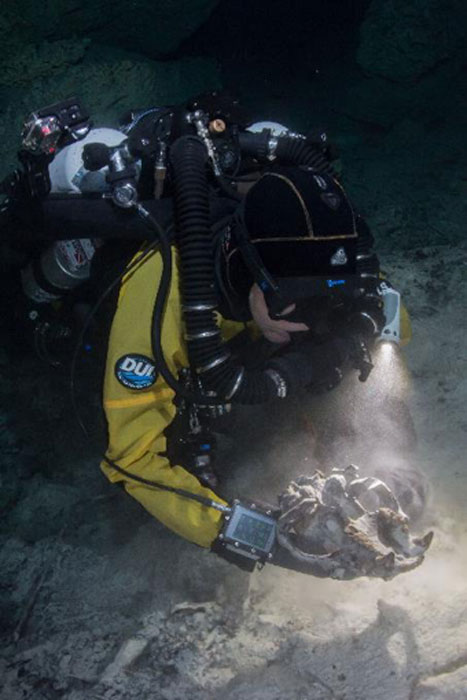Fossils of Giant Prehistoric Beasts Discovered in Underwater Ice Age Death Cave
More than 10,000 years ago, as the last Ice Age ended, vast sheets of ice receded, scarring and causing massive cracks to appear on the bridge between North and South America. At that time, the land bridge was known to have been inhabited by fearsome beasts; now new evidence shows these prehistoric beasts included giant ‘wolf-like carnivores’ and the ‘largest bear’ ever to have walked on planet Earth.
‘10,000 BC’ was a 2008 American epic adventure film set in prehistory. It told the adventures of a prehistoric tribe of mammoth hunters. After its world premiere on February 10, 2008 in Berlin, although it was an immediate box office hit, the film became regarded by professional critics as one of the worst films of the year. The Sunday Times review section noted that the film was “archaeologically inaccurate and contains many factual errors and anachronisms.” But now it would appear this movie was based firmly in reality!

A diver in the Hoyo Negro pit, holding a Protocyon jaw and vertebrae. (Roberto Chavez-Arce)
A Death Pit of Giant Prehistoric Creatures
At the bottom of an underwater cave in Mexico archaeologists have discovered an ancient graveyard including the skeletons of ancient sloths, sabretooth cats, cougars, elephant-like gomphotheres, bears, and dog-like animals. According to the researchers’ new paper, published in Biology Letters, they have recovered the skull of an enormous short-faced bear ( Arctotherium wingei) and remains of a wolf-like dog known as Protocyon troglodytes.
- Pleistocene Epoch: Humans, Welcome to Earth
- Evidence Mounts in Favor of Early Inhabitants of the Americas Over 20,000 Years Ago
- What Giant Beasts Carved Out these South American Mega-Tunnels?
Furthermore, in 2007, researchers even found “two human skeletons dating to more than 12,000-years-old.” These are now thought to be two of the “oldest human skeletons ever found in the Western hemisphere” and they inform experts that our ancestors once lived alongside giant ground sloths, towering bears, and fierce wolf-like carnivores.

Arctotherium wingei and Protocyon troglodytes from Hoyo Negro. (Schubert et al, Biology Letters, 2019)
The remarkable discoveries were made in the Hoyo Negro pit (Spanish: blackhole) in the Sac Actun cave system on the eastern coast of the Yucatán Peninsula. Researchers have described it as “an underworld of exquisitely preserved fossils” naturally formed from limestone in the Late Pleistocene. It is thought that animals fell nearly 60 meters (200 feet) into the death pit and when the melting glaciers filled the pit the remains became a permanent installation.
This large-scale archaeological project is being financially support by a consortium including INAH (National Institute of Anthropology and History), National Geographic Society, the ETSU Center of Excellence in Paleontology, the Archaeological Institute of America, and DirectAMS and Strauss Family Fund. Among the bones recovered by scientists over the past 12 years, the team of US and Mexican researchers were most impressed by the remains of a giant bear and a wolf-like creature.

Divers in the expansive underwater cave of Hoyo Negro, Tulum, Quintana Roo. (SAS. INAH)
While having been collected several years ago, both giant species were misidentified until now. But it’s not only the awe inspiring size of these two skeletons that is fascinating scientists, it’s the fact that they are causing anthropologists to redress their theories about ancient animal populations in South America.
How so? Up until their correct identification, scientists were convinced that the short-faced bear and wolf only populated the southern aspects of the South American continent, “more than 2,000 kilometers away.”
When Did these Prehistoric Beasts Travel Such Vast Distances?
Lead author and paleontologist from the East Tennessee State University, Blaine Schubert, told reporters at Live Science, “The whole previous record of this particular type of bear is just known from a few localities in South America, and those are fragmentary remains.” And having come from almost no knowledge of this bear, the scientists now have what is being called “the best record of this type of bear from the Yucatán of Mexico.”
- Bones of a Teenage Mother Who Died 12,000 Years Ago Tell Researchers a Dark Story of Carnivores and Malnutrition
- New study blames humans for megafauna extinction
- Montezuma Zoo: A Legendary Treasure of the Aztec Empire
Trying to account for how the bear and wolf got as far north as Mexico, scientists refer to “many cross-over events between North and South America.” Another possibility being proposed by the authors is that having walked all the way south, during or after the last full glacial event between 35,000 and 12,000 years ago, they returned northwards to the region of the cave. The scientists wrote, “We suggest that landscape and ecological changes caused by latest Pleistocene glaciation supported an interchange pulse that included Homo sapiens.”

Arctotherium wingei cranium being recovered. (Roberto Chávez-Arce, Schubert et al, Biology Letters, 2019)
When 10,000 BC was released in 2008 critics at Variety wrote: “10,000 BC reps a missed opportunity to present an imaginative vision of a prehistoric moment.” However, in April 29, 2008 the movie had grossed approximately $268.6 million worldwide, which was said to be “dead money.” Now, it appears the movie was a really, really expensive archaeological lesson.
Top Image: A diver holds the skull of an ancient bear known as an Arctotherium. It is one of the species of “prehistoric monsters” found in an underwater Yucatan cave. Source: Copyright Roberto Chavez-Arce
By Ashley Cowie



















